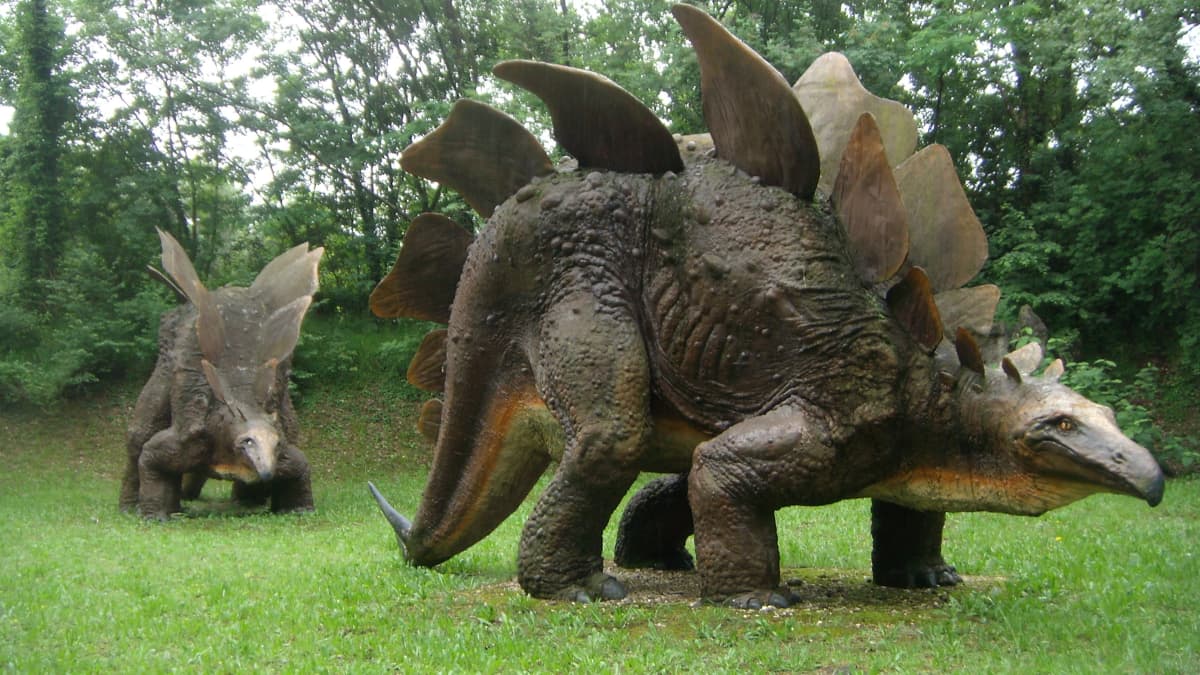
Stegosaurus, one of the most iconic dinosaurs of the Late Jurassic period, continues to captivate the imagination of people worldwide. With its distinctive double row of large bony plates along its back and formidable spikes on its tail, this herbivorous giant has left an indelible mark in the annals of paleontology.
In this article, we'll embark on an exciting journey to uncover 18 fascinating facts about the enigmatic Stegosaurus. From its physical characteristics and behavioral traits to its place in the prehistoric ecosystem, we'll delve into the depths of its existence to shed light on this magnificent creature.
Join us as we unearth the mysteries surrounding the Stegosaurus, gaining insights into its unique adaptations, its interactions with other dinosaurs, and the enduring legacy it has left in the realm of paleontology. Get ready to be enthralled by the awe-inspiring world of the Stegosaurus as we embark on a thrilling exploration of its remarkable existence.
Key Takeaways:
- The Stegosaurus, a gentle giant with a small brain, roamed the Earth over 150 million years ago, inspiring awe and fascination with its unique features and majestic presence.
- The iconic Stegosaurus, with its bony plates and tail spikes, continues to captivate audiences and inspire new generations, leaving an enduring legacy of prehistoric wonder and fascination.
The Stegosaurus was a Herbivorous Dinosaur
The Stegosaurus, a herbivorous dinosaur from the late Jurassic period, roamed the Earth over 150 million years ago. This gentle giant is known for its distinctive features, including the iconic double row of large bony plates along its back and the formidable spikes on its tail. Despite its massive size, the Stegosaurus had a relatively small brain, comparable to that of a modern-day dog. This fascinating creature is a source of endless fascination for paleontologists and dinosaur enthusiasts alike.
Stegosaurus Means "Roof Lizard"
The name "Stegosaurus" is derived from the Greek words "stegos," meaning "roof," and "sauros," meaning "lizard." This name perfectly encapsulates the dinosaur's defining characteristic—the series of bony plates that adorned its back like a protective roof. These plates, which could grow up to 2 feet in height, were not only a striking feature but also served a practical purpose, possibly regulating the dinosaur's body temperature or providing defense against predators.
The Stegosaurus Had a Tiny Brain
Despite its massive size, the Stegosaurus had a brain roughly the size of a walnut. This intriguing fact has led scientists to speculate about the cognitive abilities and behaviors of this ancient creature. The small brain of the Stegosaurus is a testament to the diverse adaptations that existed in the dinosaur kingdom, showcasing that intelligence is not solely determined by brain size.
Stegosaurus Had a Second Brain in Its Hips
Recent studies have revealed a fascinating discovery about the Stegosaurus: it possessed a "second brain" located near its hips. This structure, known as the "lumbosacral enlargement," was a concentration of nerves that may have assisted in controlling the movements of the dinosaur's hind legs and tail. This remarkable adaptation sheds light on the complexity of the Stegosaurus's nervous system and its ability to coordinate its massive body.
The Stegosaurus Had a Unique Tail Weapon
The tail of the Stegosaurus featured pairs of long, sharp spikes, known as "thagomizers," which were likely used as defensive weapons against predators. The term "thagomizer" was coined by cartoonist Gary Larson in a 1982 comic, and paleontologists subsequently adopted it as the official name for the Stegosaurus's tail spikes. This whimsical yet fitting name adds a touch of humor to the formidable defensive capabilities of this ancient herbivore.
Stegosaurus Lived in the Late Jurassic Period
The Stegosaurus thrived during the late Jurassic period, approximately 155 to 150 million years ago. This period marked the dominance of dinosaurs on land and the emergence of iconic species such as the Allosaurus and Brachiosaurus. The late Jurassic period was characterized by lush vegetation and diverse ecosystems, providing an ideal habitat for the herbivorous Stegosaurus to flourish.
Stegosaurus Fossils Have Been Found in North America and Europe
Fossils of the Stegosaurus have been discovered in various locations across North America and Europe, offering valuable insights into the distribution and evolutionary history of this remarkable dinosaur. These fossil findings have allowed scientists to reconstruct the appearance and behavior of the Stegosaurus with remarkable detail, contributing to our understanding of prehistoric life on Earth.
The Stegosaurus Had a Low Browsing Diet
As a herbivore, the Stegosaurus primarily fed on low-lying vegetation, using its beak-like mouth to strip leaves from plants. Its unique jaw structure and tooth arrangement were well-suited for processing fibrous plant material, indicating a specialized diet adapted to the available vegetation during the late Jurassic period. This dietary preference played a crucial role in shaping the ecosystem dynamics of the ancient world.
Stegosaurus Was Discovered in 1877
The first Stegosaurus fossils were unearthed in 1877 by paleontologist Othniel Charles Marsh during the "Bone Wars," a period of intense fossil discovery and rivalry in the late 19th century. This groundbreaking discovery marked the beginning of extensive research into the Stegosaurus and its place in the dinosaur lineage, captivating the imagination of scientists and the public alike.
The Stegosaurus Was a Quadrupedal Dinosaur
Despite its massive size and distinctive features, the Stegosaurus was a quadrupedal dinosaur, meaning that it walked on all fours. This mode of locomotion provided stability and support for its large body, allowing it to navigate its environment with relative ease. The image of the Stegosaurus majestically roaming the ancient landscapes on all fours evokes a sense of awe and wonder at the diversity of dinosaur adaptations.
Stegosaurus Had a Slow Walking Speed
Despite its imposing appearance, the Stegosaurus had a relatively slow walking speed, estimated to be around 4.5 miles per hour. This leisurely pace, combined with its herbivorous diet and formidable defensive features, paints a vivid picture of the Stegosaurus as a gentle giant peacefully coexisting with other prehistoric creatures in its ancient habitat.
The Purpose of the Stegosaurus's Plates Remains a Mystery
The exact purpose of the Stegosaurus's distinctive bony plates has been a subject of ongoing debate among paleontologists. While some hypotheses suggest that the plates functioned as a form of thermoregulation, aiding in heat exchange with the environment, others propose that they played a role in display or species recognition. The mystery surrounding the true function of these impressive plates adds an air of intrigue to the study of the Stegosaurus.
Stegosaurus Could Weigh Up to 5 Tons
The Stegosaurus was a massive dinosaur, with some individuals reaching lengths of up to 30 feet and weighing as much as 5 tons. This impressive size, combined with its striking appearance, solidifies the Stegosaurus's status as one of the most iconic and recognizable dinosaurs in popular culture and scientific literature.
The Stegosaurus's Tail Could Deliver Lethal Blows
The formidable tail of the Stegosaurus, armed with its array of sharp spikes, was a potent defensive weapon that could deliver lethal blows to potential predators. This unique adaptation allowed the Stegosaurus to ward off threats and protect itself and its herd, showcasing the evolutionary ingenuity of this ancient herbivore.
Stegosaurus Had a Relatively Short Lifespan
Paleontological studies have revealed that the Stegosaurus had a relatively short lifespan compared to some other dinosaurs, with individuals likely reaching maturity in their teenage years. This insight into the life cycle of the Stegosaurus provides valuable information about its growth patterns and reproductive strategies, offering a glimpse into the dynamics of prehistoric ecosystems.
The Stegosaurus's Name Reflects Its Formidable Appearance
The name "Stegosaurus," meaning "roof lizard," aptly reflects the dinosaur's formidable appearance and the imposing nature of its bony plates and tail spikes. This evocative name conjures images of a majestic and resilient creature that once roamed the ancient landscapes, leaving an indelible mark on the collective imagination of humanity.
Stegosaurus Has Inspired Countless Cultural Depictions
The iconic image of the Stegosaurus, with its distinctive plates and tail spikes, has inspired countless cultural depictions in literature, film, and art. From children's books to blockbuster movies, the Stegosaurus continues to captivate audiences and ignite the imagination, cementing its status as a beloved symbol of prehistoric wonder and the enduring allure of dinosaurs.
Stegosaurus Leaves a Lasting Legacy
The legacy of the Stegosaurus extends far beyond its impressive physical attributes and evolutionary significance. As an enduring symbol of the ancient world, this gentle giant continues to fascinate and inspire new generations of scientists, artists, and enthusiasts, perpetuating its timeless appeal and the enduring allure of the prehistoric past.
The Stegosaurus, with its iconic bony plates and formidable tail spikes, stands as a testament to the diversity and wonder of prehistoric life. This gentle giant, despite its relatively small brain, has left an indelible mark on the collective imagination, inspiring awe and fascination with its unique adaptations and majestic presence. The legacy of the Stegosaurus serves as a reminder of the enduring allure of dinosaurs and the ongoing quest to unravel the mysteries of the ancient world.
Conclusion
In conclusion, Stegosaurus is a fascinating dinosaur that roamed the Earth during the Late Jurassic period. Its distinctive features, including the double row of bony plates along its back and the array of intimidating spikes on its tail, have captured the imagination of people for generations. By understanding the behaviors, physical attributes, and environment in which Stegosaurus thrived, we gain valuable insights into the ancient world and the diverse creatures that inhabited it. The enduring allure of this magnificent herbivore continues to inspire awe and wonder, serving as a testament to the enduring legacy of the dinosaurs.
FAQs
What did Stegosaurus eat?
Stegosaurus was an herbivorous dinosaur, primarily feeding on low-lying vegetation such as ferns, mosses, and cycads. Its tooth structure suggests it was well-suited for processing fibrous plant material.
How did Stegosaurus defend itself from predators?
Stegosaurus utilized its formidable tail spikes as a means of defense against predators. By swinging its tail, it could ward off potential threats and protect itself from harm. Additionally, the bony plates along its back may have served a defensive function, potentially deterring attackers or regulating body temperature.
Stegosaurus may be your favorite dinosaur, but have you heard about Minmi? This small ankylosaur from Australia had unique armor plates protecting its body. Leaellynasaura, another Australian native, thrived during polar winters thanks to large eyes that helped navigate dark forests. Speaking of mythical creatures, dragons come in many shapes and sizes across cultures worldwide - from fire-breathing beasts to wise serpents guarding treasure hoards. Satisfy your curiosity by exploring more fascinating facts about lesser-known dinosaurs and legendary dragons!
Was this page helpful?
Our commitment to delivering trustworthy and engaging content is at the heart of what we do. Each fact on our site is contributed by real users like you, bringing a wealth of diverse insights and information. To ensure the highest standards of accuracy and reliability, our dedicated editors meticulously review each submission. This process guarantees that the facts we share are not only fascinating but also credible. Trust in our commitment to quality and authenticity as you explore and learn with us.


